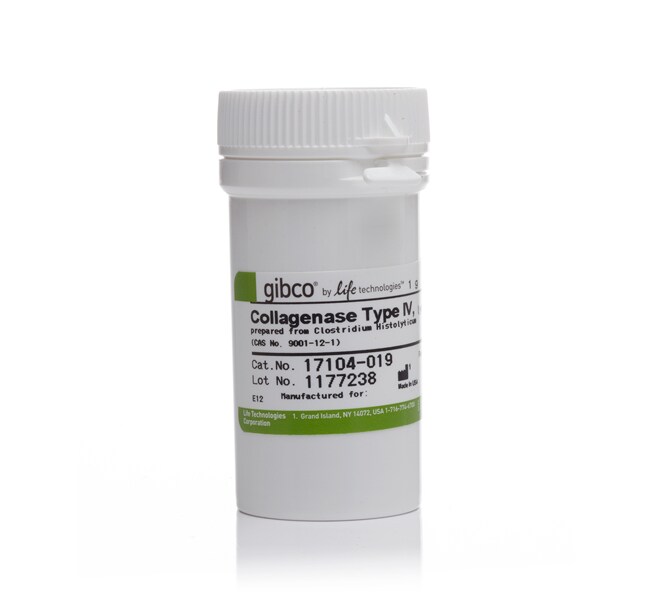Search Thermo Fisher Scientific

Collagenase, Type IV, powder
| Catalog Number | Quantity |
|---|---|
| 17104019 | 1 g |
Gibco™ Collagenase Type IV is isolated from Clostridium histolyticum and packaged as a lyophilized, non-sterile powder for research use in cell or tissue dissociation and organ perfusions. Gibco™ Collagenase Type IV activity is guaranteed to be greater than 160 units/mg. Compared to other collagenase preparations, Gibco™ Collagenase Type IV has low tryptic activity and is well-suited for the digestion of islet cells from the pancreas.
Shipping conditions: Room temperature
Shelf life: 24 months from date of manufacture
Customers who viewed this item also viewed
Documents & Downloads
Certificates
Safety Data Sheets
Frequently asked questions (FAQs)
1. Add 1 mL Hanks' Balanced Salt Solution (HBSS) with calcium and magnesium directly to 1 g vial of Collagenase. Vortex gently to ensure complete dissolution. Transfer to a clean tube.
2. Determine volume of HBSS (with calcium and magnesium) required to bring collagenase solution to 100 U/µL (1000X stock solution). The activity is lot- specific. Rinse vial with this volume of HBSS (with calcium and magnesium), and combine. Filter sterilize 1000X stock solution with a low protein binding filtration unit.
Example: Assuming the lot you have purchased has an activity of 265 U/mg, this lot will have 265000 Units per mL when you reconstitute collagenase into HBSS (with calcium and magnesium) at 1 g/mL. In order to dilute 265000 U/L to 100000 U/mL (= 100 U/µL), you need to dilute the 1 g/mL enzyme solution 2.65 fold.
Find additional tips, troubleshooting help, and resources within our Cell Culture Support Center.
Actually, in a feeder-based culture, dispase (2 mg/mL) should take about 15-25 min to work at 37 degrees C. Two to three minutes' dissociation time would apply to feeder-free cultures. Dispase is a more aggressive enzyme, so it works faster, but that also means that when the PSC clumps are harvested, they are more sensitive to being broken apart by trituration. Once the clumps are harvested, they should be pipetted up and down a few times to break up the clumps to the appropriate size. If the cells are harvested with collagenase type IV, they have to be pipetted more times because the clumps are harder to break up, but this means that there is less likelihood to break up the clumps into pieces that are too small. If the cells are harvested with dispase, they have to be pipetted fewer times, and care has to be taken to ensure that the clumps are not broken too much. Either enzyme is fine to use, and if you have enough experience, you may prefer to use dispase to save time. But for a less experienced user, we recommend using collagenase type IV as it is safer and you are less likely to ruin your culture by over-triturating.
Find additional tips, troubleshooting help, and resources within our Cell Culture Support Center.
Please use this selection chart that compares our cell dissociation reagents (https://www.thermofisher.com/us/en/home/life-science/cell-culture/mammalian-cell-culture/reagents/trypsin.html).
Find additional tips, troubleshooting help, and resources within ourMammalian Cell Culture Basics Support Center.
